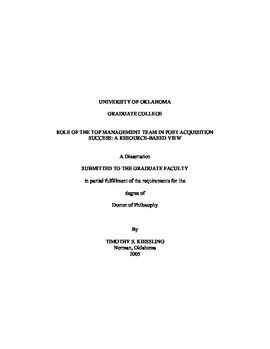| dc.contributor.advisor | Sharfman, Mark, | en_US |
| dc.contributor.author | Kiessling, Timothy S. | en_US |
| dc.date.accessioned | 2013-08-16T12:19:36Z | |
| dc.date.available | 2013-08-16T12:19:36Z | |
| dc.date.issued | 2005 | en_US |
| dc.identifier.uri | https://hdl.handle.net/11244/815 | |
| dc.description.abstract | This research focuses on the TMT, their retention, the particular characteristics of the TMT (their networks, knowledge, dynamic capability), these characteristics moderated by both acquisition type and competitive environment, and their value to the acquiring firm to help explain the variation in post-acquisition success of the acquired firm. Finally, this research focuses on smaller acquisitions, which are the majority as opposed to most previous research that focused on larger acquisitions only. This research also examines primary data from acquisition managers as opposed to the secondary (archival) data that has dominated most previous work on acquisitions. | en_US |
| dc.description.abstract | Our findings suggest that Pre-Acquisition performance of the target firm correlates with top management team (TMT) retention. Higher TMT retention was found to positively correlate with Post-Acquisition performance and that Pre-Acquisition performance does not correlate with post-acquisition performance. TMT knowledge, TMT network and TMT dynamic capability were found to be positively significant to post-acquisition performance. We controlled for the size of the acquirer versus the acquired, how the firm was purchased and the type of ownership of the acquired firm. | en_US |
| dc.description.abstract | The acquisition strategy is likely the most popular corporate strategy for growth. Research continues to explore this strategy and suggest that acquisitions occur for numerous reasons: rapid renewal in a global marketplace, creating synergies, ensuring financial and tax advantages, establishing market power, and the market for corporate control. However, a large body of research suggests that top management team (TMT) failure and improvement in efficiency is the key role for acquisitions, as argued in the market for corporate control literature. An important research question that researchers continue to explore is the disposition of the TMT subsequent to acquisition and its impact on acquisition performance. | en_US |
| dc.format.extent | x, 161 leaves : | en_US |
| dc.subject | Business Administration, Management. | en_US |
| dc.subject | Consolidation and merger of corporations. | en_US |
| dc.title | Role of the top management team in post-acquisition success: A resource-based view. | en_US |
| dc.type | Thesis | en_US |
| dc.thesis.degree | Ph.D. | en_US |
| dc.thesis.degreeDiscipline | Michael F. Price College of Business | en_US |
| dc.note | Adviser: Mark Sharfman. | en_US |
| dc.note | Source: Dissertation Abstracts International, Volume: 65-11, Section: A, page: 4260. | en_US |
| ou.identifier | (UMI)AAI3152838 | en_US |
| ou.group | Michael F. Price College of Business | |
